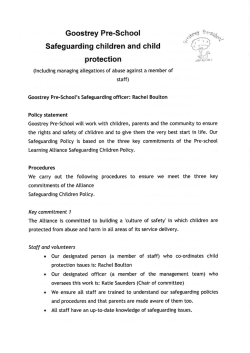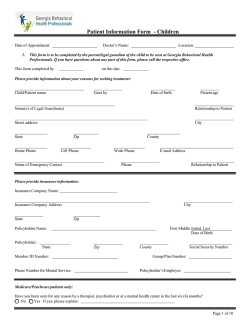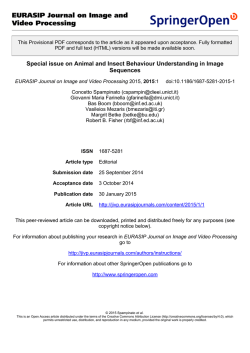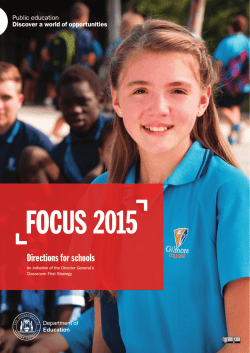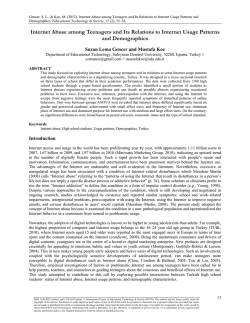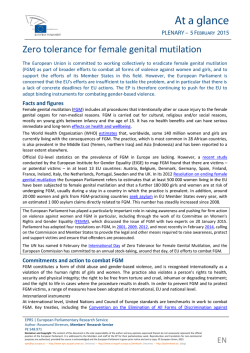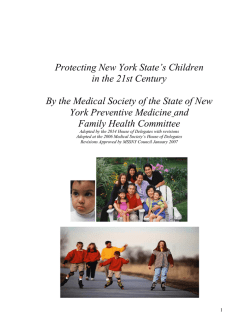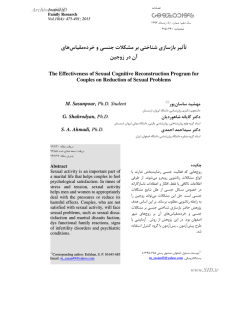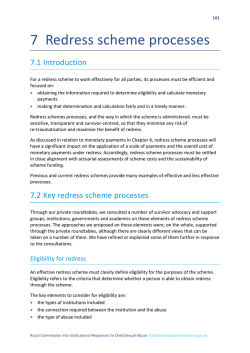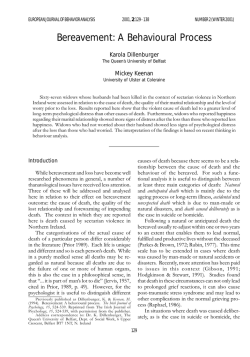
A6 Policy Safeguarding Children
OAKHYRST GRANGE SCHOOL SAFEGUARDING CHILDREN POLICY BASED ON THE SURREY MODEL CHILD PROTECTION POLICY FOR SCHOOLS Oakhyrst Grange School is committed to safeguarding and promoting the welfare of children and young people and expects all staff and volunteers to share this commitment. At this school we respect and value all children and are committed to providing a caring, friendly and safe environment for our pupils so that they can learn in a relaxed and secure atmosphere. We believe that every pupil should be able to participate in all school activities in an enjoyable and safe environment and be protected from harm. This is the responsibility of every adult employed by, or invited to deliver services at Oakhyrst Grange School. We recognise our responsibility to safeguard all who access school and promote the welfare of all of our pupils by protecting them from physical, sexual and emotional abuse, neglect and bullying. Updated 24th March 2009 Updated 5th May 2010 Reviewed 14th January 2011 (AG/LP) Reviewed 12.09.2011 AG Reviewed AG 19.10.12 AG to attend further training 9.11.12 Updated AG 15.11.12 Reviewed and Updated AG 03.10.13 Reviewed and Updated AG 06.02.14 Reviewed and Updated AG 14.05.14 Reviewed AG 15.09.14 Updated AG 10.10.14 Reviewed and Updated (following inset) 01/15 The telephone numbers are correct at the date of printing 1 Safeguarding Children Policy Oakhyrst Grange School This policy was developed at our inset day 7th January and adopted on 8th January 2009. The Child Protection Liaison Officers for the school are Mr Alex Gear, Headmaster and Mrs Paula Pumphrey, Head of Sport and PSHE This policy will be reviewed during the academic year 2015/2016. 1.0 Introduction 1.1 This policy has been developed in accordance with the principles established by the Children Acts 1989 and 2004; the Education Act 2002, and in line with government publications: ‘Working Together to Safeguard Children’ 2013, Revised Safeguarding Statutory Guidance 2 ‘Framework for the Assessment of Children in Need and their Families’ 2000, ‘What to do if You are Worried a Child is Being Abused’ 2003. The guidance reflects, both ‘Keeping Children Safe in Education’ 2014, and Surrey Safeguarding Children Board SSCB Child Protection Procedures1 1.2 The Governing body takes seriously its responsibility under section 175 of the Education Act 2002 to safeguard and promote the welfare of children; and to work together with other agencies to ensure adequate arrangements within our school to identify, assess, and support those children who are suffering harm. 1.3 We recognise that all adults, including temporary staff2, volunteers and governors, have a full and active part to play in protecting our pupils from harm, and that the child’s welfare is our paramount concern. 1.4 All staff believe that our school should provide a caring, positive safe and stimulating environment that promotes the social, physical and moral development of the individual child. 1.5 The aims of this policy are: 1.5.1 1.5.2 1.5.3 To support the child’s development in ways that will foster security, confidence and independence. To provide an environment in which children and young people feel safe, secure, valued and respected, and feel confident, and know how to approach adults if they are in difficulties, believing they will be effectively listened to. To raise the awareness of all teaching and non-teaching staff of the need to safeguard children and of their responsibilities in identifying 1 The SSCB Child protection Procedures are only available online at www.surreycc.gov.uk/safeguarding 2 Wherever the word “staff” is used, it covers ALL staff on site, including ancillary supply and self employed staff, contractors, volunteers working with children etc, and governors 2 1.5.4 1.5.5 1.5.6 1.5.7 1.5.8 2.0 Safe School, Safe Staff 2.1 We will ensure that: 2.1.1 3 and reporting possible cases of abuse (Reference Appendices 1 and 2) To provide a systematic means of monitoring children known or thought to be at risk of harm, and ensure we, the school, contribute to assessments of need and support packages for those children. To emphasise the need for good levels of communication between all members of staff. To develop a structured procedure within the school, which will be followed by all members of the school community in cases of suspected abuse. To develop and promote effective working relationships with other agencies, especially the Police and Social Care. To ensure that all staff working within our school who have substantial access to children have been checked as to their suitability, including verification of their identity, qualifications, and a satisfactory DBS check (according to guidance)3, and a central record is kept for audit. All members of the governing body understand and fulfil their responsibilities, namely to ensure that: there is a Child Protection policy together with a staff behaviour (code of conduct) policy the school operates safer recruitment procedures by ensuring that there is at least one person on every recruitment panel that has completed Safer Recruitment training the school has procedures for dealing with allegations of abuse against staff and volunteers and to make a referral to the DBS if a person in regulated activity has been dismissed or removed due to safeguarding concerns, or would have had they not resigned. a senior leader has Lead Designated Child Protection Officer (DCPO) responsibility on appointment, the DCPOs undertake interagency training (SSCB Modules 1&2) and also undertake DCPO ‘New to Role’ and the ‘Update’ Course every 2 years all other staff have Safeguarding training updated as appropriate any weaknesses in Child Protection are remedied immediately a member of the Governing Body is, usually the Chair, is nominated to liaise with the LA on Child Protection issues and in the event of an allegation of abuse made against the Headmaster Child Protection policies and procedures are reviewed annually and that the Child Protection policy is available on the school website or by other means the Governing Body considers how children may be taught about safeguarding. This may be part of a broad and balanced curriculum covering relevant issues through personal social health and economic education (PSHE) and/or for maintained schools through sex and relationship education (SRE). Guidance regarding CRB checks recently updated by the Protection of Freedoms Act 2012 3 that enhanced DBS checks are in place for Chairs of Governors of independent, academies, non-maintained special schools 2.1.2 The Lead DCPO is Mr Alex Gear the Headmaster. The Deputy Designated Child Protection Officer is Mrs Paula Pumphrey. These Officers have undertaken the compulsory training delivered through the SSCB (2 days), or by an approved external training provider, and, upon appointment will undertake ‘DCPO New to Role’ training followed by biannual updates. 2.1.3 The DCPO’s who are involved in recruitment and at least one member of the governing body will also complete Safer Recruitment Training (currently on-line on the DfE website) to be renewed every 5 years 2.1.4 All members of staff and volunteers are provided with child protection awareness information at induction, including in their arrival pack, the school safeguarding statement so that they know who to discuss a concern with. 2.1.5 All members of staff are trained in and receive regular updates in esafety and reporting concerns (Ref Appendix 3) 2.1.6 All other staff and governors, have child protection awareness training, updated by the DCPO as appropriate, to maintain their understanding of the signs and indicators of abuse. 2.1.7 All members of staff, volunteers, and governors know how to respond to a pupil who discloses abuse through delivery of the Awareness Raising pack. 2.1.8 All parents/carers are made aware of the responsibilities of staff members with regard to child protection procedures through publication of the school’s Child Protection Policy, and reference to it in our Parents’ Handbook. 2.1.9 Our lettings policy will seek to ensure the suitability of adults working with children on school sites at any time. 2.1.10 Community users organising activities for children are aware of the school’s child protection guidelines and procedures. 2.1.11 We will ensure that child protection type concerns or allegations against adults working in the school are referred to the LADO4 for advice , and that any member of staff found not suitable to work with children will be notified to the Disclosure and Barring Service (DBS)5 for consideration for barring, following resignation, dismissal, or when we cease to use their service as a result of a substantiated allegation, in the case of a volunteer. 2.2 Our procedures will be regularly reviewed and up-dated. 2.3 The name of the designated members of staff for Child Protection, the Designated Child Protection Officers, will be clearly advertised in the school, with a statement explaining the school’s role in referring and monitoring cases of suspected abuse. 2.4 All new members of staff will be given a copy of our safeguarding statement, and child protection policy, with the DCPOs’ names clearly displayed, as part of their induction into the school. 4 LADO Local Authority Designated Officer for allegations against staff. AEO Area Education Officer or Duty LADO via 0300 200 1006. 5 Contact the LADO for guidance in any case 4 2.5 3.0 The policy is available publicly either on the school website. Parents/carers are made aware of this policy and their entitlement to have a copy of it via the school handbook/newsletter/website Responsibilities 3.1 The designated DCPOs are responsible for: 3.1.1 3.1.2 3.1.3 3.1.4 3.1.5 3.1.6 3.1.7 3.1.8 3.1.9 4.0 Referring a child if there are concerns about possible abuse, to the Children’s’ Services Area Team6, and acting as a focal point for staff to discuss concerns. Referrals should be made in writing, following a telephone call using the Multi Agency Referral Form (MARF)7 Keeping written records of concerns about a child even if there is no need to make an immediate referral. Ensuring that all such records are kept confidentially and securely and are separate from pupil records, until the child’s 25th birthday, and are copied on to the child’s next school or college. Ensuring that an indication of the existence of the additional file in 3.1.3 above is marked on the pupil records. Liaising with other agencies and professionals. Ensuring that either they or the staff member attend case conferences, core groups, or other multi-agency planning meetings, contribute to assessments, and provide a report which has been shared with the parents. Ensuring that any pupil currently with a child protection plan who is absent in the educational setting without explanation for two days is referred to their key worker’s Social Care Team. Organising child protection induction, and update training every 3 years, for all school staff. The Headmaster will provide an annual report for the governing body, detailing any changes to the policy and procedures; training undertaken by the DCPO, and by all staff and governors; number and type of incidents/cases, and number of children on the child protection register (anonymised)8 Supporting Children 4.1 We recognise that a child who is abused or witnesses violence may feel helpless and humiliated, may blame themselves, and find it difficult to develop and maintain a sense of self worth. 4.2. We recognise that the school may provide the only stability in the lives of children who have been abused or who are at risk of harm. 4.3. We accept that research shows that the behaviour of a child in these circumstances may range from that which is perceived to be normal to aggressive or withdrawn. 6 All new referrals go to the Contact Centre Children’s Team 0300 200 1006 (Fax 020 8541 7309) operating 8.00am to 6.00pm. CPLOs may consult with an Assistant Team Manager by telephoning 0208 541 7041/7042.In an emergency out of hours, referrals can be made to the Emergency Duty Team on 01483 517898. 7 On line forms will be e-mailed from the Children’s Services Area Team 8 Format for the Governors Annual Report is available from Governor Services and at www.surreycc.gov.uk/safeguardingchildren 5 4.4. Our school will support all children by: 4.4.1 4.4.2 4.4.3 4.4.4 4.4.5 5.0 6.0 7.0 Encouraging self-esteem and self-assertiveness, through the curriculum as well as our relationships, whilst not condoning aggression or bullying. Promoting a caring, safe and positive environment within the school. Liaising and working together with all other support services and those agencies involved in the safeguarding of children. Notifying Social Care as soon as there is a significant concern. Providing continuing support to a child about whom there have been concerns who leaves the school by ensuring that appropriate information is copied under confidential cover to the child’s new setting and ensuring the school medical records are forwarded as a matter of priority. Confidentiality 5.1 We recognise that all matters relating to child protection are confidential. 5.2 The Headmaster or DCPOs will disclose any information about a child to other members of staff on a need to know basis only.9 5.3 All staff must be aware that they have a professional responsibility to share information with other agencies in order to safeguard children. 5.4 All staff must be aware that they cannot promise a child to keep secrets which might compromise the child’s safety or wellbeing. 5.5 We will always undertake to share our intention to refer a child to Social Care with their parents /carers unless to do so could put the child at greater risk of harm, or impede a criminal investigation. If in doubt, we will consult with an Assistant Team Manager at the Children’s Services Area Team on this point. Supporting Staff 6.1 We recognise that staff working in the school who have become involved with a child who has suffered harm, or appears to be likely to suffer harm may find the situation stressful and upsetting. 6.2 We will support such staff by providing an opportunity to talk through their anxieties with the DCPOs and to seek further support as appropriate. Allegations against staff 7.1 All school staff should take care not to place themselves in a vulnerable position with a child. It is always advisable for interviews or work with individual children or parents to be conducted in view of other adults. 9 Guidance about sharing information, can be found in the DfE booklet ‘Information sharing guidance for practitioners and managers’ DCSF-00807-2008 6 8.0 7.2 All Staff should be aware of Surrey’s Guidance on Behaviour Issues, and the school’s own Behaviour Management policy. 7.3 Guidance about conduct and safe practice, including safe use of mobile phones by staff and volunteers will be given at induction10 7.4 We understand that a pupil may make an allegation against a member of staff. 7.5 If such an allegation is made, or information is received which suggests that a person may be unsuitable to work with children, the member of staff receiving the allegation or aware of the information, will immediately inform the Headmaster11. 7.6 The Headmaster on all such occasions will discuss the content of the allegation with the Local Authority Designated Officer (LADO)12 7.7 If the allegation made to a member of staff concerns the Headmaster, the person receiving the allegation will immediately inform the Chair of Governors who will consult as in 7.6 above, without notifying the Headmaster first. 7.8 The school will follow the Surrey procedures for managing allegations against staff. Under no circumstances will we send a child home, pending such an investigation, unless this advice is given exceptionally, as a result of a consultation with the LADO. 7.9 Suspension of the member of staff, excluding the Headmaster, against whom an allegation has been made, needs careful consideration, and the Headmaster will seek the advice of the LADO and Personnel Consultant in making this decision. 7.10 In the event of an allegation against the Headmaster, the decision to suspend will be made by the Chair of Governors with advice as in 7.8 above. 7.11 We have a procedure for managing the suspension of a contract for a community user in the event of an allegation arising in that context. Whistle-blowing 8.1 We recognise that children cannot be expected to raise concerns in an environment where staff fail to do so. 8.2 All staff should be aware of their duty to raise concerns, where they exist, about the management of child protection, which may include the attitude or actions of colleagues. If it becomes necessary to consult outside the school, they should speak in the first instance, to the Area Education Officer/LADO following the Whistleblowing Policy. 10 Refer to “Guidance for Safe Working Practice for the Protection of Children and Staff in Education Settings” available on the DfE website, also the SCC e-safety toolkit http://www.surreycc.gov.uk/learning/teachers-andeducation-staff/education-safeguarding/e-safety 11 or Chair of Governors in the event of an allegation against the Headmaster 12 Duty LADO 0300 200 1006 7 8.3 9.0 10.0 Physical Intervention 9.1 We acknowledge that staff must only ever use physical intervention as a last resort, when a child is endangering him/herself or others, and that at all times it must be the minimal force necessary to prevent injury to another person. 9.2 Such events should be recorded and signed by a witness. 9.3 Staff who are likely to need to use physical intervention will be appropriately trained in the Positive Options technique. 9.4 We understand that physical intervention of a nature which causes injury or distress to a child may be considered under child protection or disciplinary procedures. 9.5 We recognise that touch is appropriate in the context or working with children, and all staff have been given ‘Safe Practice’ guidance to ensure they are clear about their professional boundary.13 Anti-Bullying 10.1 11.0 Our school policy on anti-bullying is set out in a separate document and acknowledges that to allow or condone bullying may lead to consideration under child protection procedures. This includes all forms .g. cyber, racist, homophobic and gender related bullying. We keep a record of known bullying incidents. All staff are aware that children with SEND and / or differences/perceived differences are more susceptible to being bullied / victims of child abuse. We keep a record of bullying incidents. Racist Incidents 11.1 12.0 Whistle-blowing re the Headmaster should be made to the Chair of the Governing Body whose contact details are readily available to staff (as pertinent to setting). Our policy on racist incidents is set out separately, and acknowledges that repeated racist incidents or a single serious incident may lead to consideration under child protection procedures. We keep a record of racist incidents. Prevention 12.1 We recognise that the school plays a significant part in the prevention of harm to our children by providing children with good lines of communication with trusted adults, supportive friends and an ethos of protection. 12.2 The school community will therefore: 12.2.1 Work to establish and maintain an ethos where children feel secure and are encouraged to talk and are always listened to. 12.2.2 Include regular consultation with children e.g. through safety questionnaires, participation in anti-bullying week, asking children to report whether they have had happy/sad lunchtimes/playtimes 13 ‘Guidance on Safer Working Practices is available on the DfE website 8 12.2.3 Ensure that all children know there is an adult in the school whom they can approach if they are worried or in difficulty. 12.2.4 Include safeguarding across the curriculum, including PSHE, opportunities which equip children with the skills they need to stay safe from harm and to know to whom they should turn for help. In particular this will include anti-bullying work, e-safety, road safety, pedestrian and cycle training. Also focussed work in Year 6 to prepare for transition to Secondary school and more personal safety/independent travel. 12.2.5 Ensure all staff are aware of school guidance for their use of mobile technology and have discussed safeguarding issues around the use of mobile technologies and their associated risks. NB schools to check with SCC e-safety guidance Appendix 11 to ‘cherry pick’ statements relevant to their setting www.surreyesafety.co.uk 13.0 Health & Safety 13.1 14.0 Our Health & Safety policy, set out in a separate document, reflects the consideration we give to the protection of our children both physically within the school environment, and for example in relation to internet use, and when away from the school and when undertaking school trips and visits. Monitoring and Evaluation Our Child Protection Policy and Procedures will be monitored and evaluated by: Governing Body visits to the school SLT ‘drop ins’ and discussions with children and staff Pupil surveys and questionnaires Scrutiny of Attendance data Scrutiny of range of risk assessments Scrutiny of GB minutes Logs of bullying/racist/behaviour incidents for SLT and GB to monitor Review of parental concerns and parent questionnaires Review of the use of nurture room and fun club at lunchtime This policy also links to our policies on: Behaviour, Staff Behaviour Policy / Code of Conduct Whistleblowing Anti-bullying Health & Safety Complaints Attendance Curriculum PSHE/Health Education Administration of medicines First Aid Drug Education Sex and Relationships Education Physical intervention Intimate Care ESafety, including staff use of mobile phones Risk Assessment Safer Recruitment Grievance Procedure 9 Appendix one Recognising signs of child abuse Categories of Abuse: • Physical Abuse • Emotional Abuse (including Domestic Abuse) • Sexual Abuse • Neglect Signs of Abuse in Children: The following non-specific signs may indicate something is wrong: • Significant change in behaviour • Extreme anger or sadness • Aggressive and attention-seeking behaviour • Suspicious bruises with unsatisfactory explanations • Lack of self-esteem • Self-injury • Depression • Age inappropriate sexual behaviour • Child Sexual Exploitation. Risk Indicators The factors described in this section are frequently found in cases of child abuse. Their presence is not proof that abuse has occurred, but: Must be regarded as indicators of the possibility of significant harm Justifies the need for careful assessment and discussion with designated / named / lead person, manager, (or in the absence of all those individuals, an experienced colleague) May require consultation with and / or referral to Children’s Services The absence of such indicators does not mean that abuse or neglect has not occurred. In an abusive relationship the child may: Appear frightened of the parent/s Act in a way that is inappropriate to her/his age and development (though full account needs to be taken of different patterns of development and different ethnic groups) The parent or carer may: 10 Persistently avoid child health promotion services and treatment of the child’s episodic illnesses Have unrealistic expectations of the child Frequently complain about/to the child and may fail to provide attention or praise (high criticism/low warmth environment) Be absent or misusing substances Persistently refuse to allow access on home visits Be involved in domestic abuse Staff should be aware of the potential risk to children when individuals, previously known or suspected to have abused children, move into the household. Recognising Physical Abuse The following are often regarded as indicators of concern: An explanation which is inconsistent with an injury Several different explanations provided for an injury Unexplained delay in seeking treatment The parents/carers are uninterested or undisturbed by an accident or injury Parents are absent without good reason when their child is presented for treatment Repeated presentation of minor injuries (which may represent a “cry for help” and if ignored could lead to a more serious injury) Family use of different doctors and A&E departments Reluctance to give information or mention previous injuries Bruising Children can have accidental bruising, but the following must be considered as non accidental unless there is evidence or an adequate explanation provided: Any bruising to a pre-crawling or pre-walking baby Bruising in or around the mouth, particularly in small babies which may indicate force feeding Two simultaneous bruised eyes, without bruising to the forehead, (rarely accidental, though a single bruised eye can be accidental or abusive) Repeated or multiple bruising on the head or on sites unlikely to be injured accidentally Variation in colour possibly indicating injuries caused at different times The outline of an object used e.g. belt marks, hand prints or a hair brush Bruising or tears around, or behind, the earlobe/s indicating injury by pulling or twisting Bruising around the face Grasp marks on small children Bruising on the arms, buttocks and thighs may be an indicator of sexual abuse 11 Bite Marks Bite marks can leave clear impressions of the teeth. Human bite marks are oval or crescent shaped. Those over 3 cm in diameter are more likely to have been caused by an adult or older child. A medical opinion should be sought where there is any doubt over the origin of the bite. Burns and Scalds It can be difficult to distinguish between accidental and non-accidental burns and scalds, and will always require experienced medical opinion. Any burn with a clear outline may be suspicious e.g.: Circular burns from cigarettes (but may be friction burns if along the bony protuberance of the spine) Linear burns from hot metal rods or electrical fire elements Burns of uniform depth over a large area Scalds that have a line indicating immersion or poured liquid (a child getting into hot water is his/her own accord will struggle to get out and cause splash marks) Old scars indicating previous burns/scalds which did not have appropriate treatment or adequate explanation Scalds to the buttocks of a small child, particularly in the absence of burns to the feet, are indicative of dipping into a hot liquid or bath. Fractures Fractures may cause pain, swelling and discolouration over a bone or joint. Non-mobile children rarely sustain fractures. There are grounds for concern if: The history provided is vague, non-existent or inconsistent with the fracture type There are associated old fractures Medical attention is sought after a period of delay when the fracture has caused symptoms such as swelling, pain or loss of movement There is an unexplained fracture in the first year of life 12 Scars A large number of scars or scars of different sizes or ages, or on different parts of the body, may suggest abuse. Recognising Emotional Abuse Emotional abuse may be difficult to recognise, as the signs are usually behavioural rather than physical. The manifestations of emotional abuse might also indicate the presence of other kinds of abuse. The indicators of emotional abuse are often also associated with other forms of abuse. The following may be indicators of emotional abuse: Developmental delay Abnormal attachment between a child and parent/carer e.g. anxious, indiscriminate or not attachment Indiscriminate attachment or failure to attach Aggressive behaviour towards others Scape-goated within the family Frozen watchfulness, particularly in pre-school children Low self esteem and lack of confidence Withdrawn or seen as a “loner” – difficulty relating to others Recognising Signs of Sexual Abuse Boys and girls of all ages may be sexually abused and are frequently scared to say anything due to guilt and/or fear. This is particularly difficult for a child to talk about and full account should be taken of the cultural sensitivities of any individual child/family. Recognition can be difficult, unless the child discloses and is believed. There may be no physical signs and indications are likely to be emotional/behavioural. Some behavioural indicators associated with this form of abuse are: Inappropriate sexualised conduct Sexually explicit behaviour, play or conversation, inappropriate to the child’s age Continual and inappropriate or excessive masturbation Self-harm (including eating disorder), self mutilation and suicide attempts Involvement in prostitution or indiscriminate choice of sexual partners An anxious unwillingness to remove clothes e.g. for sports events (but this may be related to cultural norms or physical difficulties) 13 Some physical indicators associated with this form of abuse are: Pain or itching of genital area Blood on underclothes Pregnancy in a younger girl where the identity of the father is not disclosed Physical symptoms such as injuries to the genital or anal area, bruising to buttocks, abdomen and thighs, sexually transmitted disease, presence of semen on vagina, anus, external genitalia or clothing Sexual Abuse by Young People The boundary between what is abusive and what is part of normal childhood or youthful experimentation can be blurred. The determination of whether behaviour is developmental, inappropriate or abusive will hinge around the related concepts of true consent, power imbalance and exploitation. This may include children and young people who exhibit a range of sexually problematic behaviour such as indecent exposure, obscene telephone calls, fetishism, bestiality and sexual abuse against adults, peers or children. Developmental Sexual Activity encompasses those actions that are to be expected from children and young people as they move from infancy through to an adult understanding of their physical, emotional and behavioural relationships with each other. Such sexual activity is essentially information gathering and experience testing. It is characterised by mutuality and of the seeking of consent. Inappropriate Sexual Behaviour can be inappropriate socially, in appropriate to development, or both. In considering whether behaviour fits into this category, it is important to consider what negative effects it has on any of the parties involved and what concerns it raises about a child or young person. It should be recognised that some actions may be motivated by information seeking, but still cause significant upset, confusion, worry, physical damage, etc. it may also be that the behaviour is “acting out” which may derive from other sexual situations to which the child or young person has been exposed. If an act appears to have been inappropriate, there may still be a need for some form of behaviour management or intervention. For some children, educative inputs may be enough to address the behaviour. Abusive sexual activity included any behaviour involving coercion, threats, aggression together with secrecy, or where one participant relies on an unequal power base. Assessment In order to more fully determine the nature of the incident the following factors should be given consideration. The presence of exploitation in terms of: Equality – consider differentials of physical, cognitive and emotional development, power and control and authority, passive and assertive tendencies Consent – agreement including all the following: o Understanding that is proposed based on age, maturity, development level, functioning and experience 14 o Knowledge of society’s standards for what is being proposed o Awareness of potential consequences and alternatives o Assumption that agreements or disagreements will be respected equally o Voluntary decision o Mental competence Coercion – the young perpetrator who abuses may use techniques like bribing, manipulation and emotional threats of secondary gains and losses that is loss of love, friendship, etc. Some may use physical force, brutality or the threat of these regardless of victim resistance. In evaluating sexual behaviour of children and young people, the above information should be used only as a guide. Further information and advice is available in the Surrey multiagency protocol “Working with Sexually Active Young People” available at www.surreycc.gov.uk/safeguarding, by choosing Safeguarding Children – Protocols and Guidance for Professionals. Assessment, Consultation and Therapy (ACT) 01306 745310 can also assist professionals in identifying sexual behaviour of concern in children and adolescents. Recognising Neglect Evidence of neglect is built up over a period of time and can cover different aspects of parenting. Indicators include: Failure by parents or carers to meet the basic essential needs e.g. adequate food, clothes, warmth, hygiene and medical care A child seen to be listless, apathetic and irresponsive with no apparent medical cause Failure of child to grow within normal expected pattern, with accompanying weight loss Child thrives away from home environment Child frequently absent from school Child left with adults who are intoxicated or violent Child abandoned or left alone for excessive periods Child Sexual Exploitation The following list of indicators is not exhaustive or definitive but it does highlight common signs which can assist professionals in identifying children or young people who may be victims of sexual exploitation. Signs include: underage sexual activity inappropriate sexual or sexualised behaviour sexually risky behaviour, 'swapping' sex repeat sexually transmitted infections in girls, repeat pregnancy, abortions, miscarriage 15 receiving unexplained gifts or gifts from unknown sources having multiple mobile phones and worrying about losing contact via mobile having unaffordable new things (clothes, mobile) or expensive habits (alcohol, drugs) changes in the way they dress going to hotels or other unusual locations to meet friends seen at known places of concern moving around the country, appearing in new towns or cities, not knowing where they are getting in/out of different cars driven by unknown adults having older boyfriends or girlfriends contact with known perpetrators involved in abusive relationships, intimidated and fearful of certain people or situations hanging out with groups of older people, or anti-social groups, or with other vulnerable peers associating with other young people involved in sexual exploitation recruiting other young people to exploitative situations truancy, exclusion, disengagement with school, opting out of education altogether unexplained changes in behaviour or personality (chaotic, aggressive, sexual) mood swings, volatile behaviour, emotional distress self-harming, suicidal thoughts, suicide attempts, overdosing, eating disorders drug or alcohol misuse getting involved in crime police involvement, police records involved in gangs, gang fights, gang membership injuries from physical assault, physical restraint, sexual assault. 16 Appendix two Forced Marriage(FM) This is an entirely separate issue from arranged marriage. It is a human rights abuse and falls within the Crown Prosecution Service definition of domestic violence. Young men and women can be at risk in affected ethnic groups. Whistle-blowing may come from younger siblings. Other indicators may be detected by changes in adolescent behaviours. Never attempt to intervene directly as a school or through a third party. Always call either the Contact Centre or the Forced Marriage Unit 020 7008 0151. Female Genital Mutilation (FGM) It is essential that staff are aware of FGM practices and the need to look for signs, symptoms and other indicators of FGM. What is FGM? It involves procedures that intentionally alter/injure the female genital organs for non-medical reasons. 4 types of procedure: Type 1 Clitoridectomy – partial/total removal of clitoris Type 2 Excision – partial/total removal of clitoris and labia minora Type 3 Infibulation entrance to vagina is narrowed by repositioning the inner/outer labia Type 4 all other procedures that may include: pricking, piercing, incising, cauterising and scraping the genital area. Why is it carried out? Belief that: FGM brings status/respect to the girl – social acceptance for marriage Preserves a girl’s virginity Part of being a woman / rite of passage Upholds family honour Cleanses and purifies the girl Gives a sense of belonging to the community Fulfils a religious requirement Perpetuates a custom/tradition Helps girls be clean / hygienic Is cosmetically desirable Mistakenly believed to make childbirth easier 17 Is FGM legal? FGM is internationally recognised as a violation of human rights of girls and women. It is illegal in most countries including the UK. Circumstances and occurrences that may point to FGM happening are: Child talking about getting ready for a special ceremony Family taking a long trip abroad Child’s family being from one of the ‘at risk’ communities for FGM (Kenya, Somalia, Sudan, Sierra Leon, Egypt, Nigeria, Eritrea as well as non-African communities including Yemeni, Afghani, Kurdistan, Indonesia and Pakistan) Knowledge that the child’s sibling has undergone FGM Child talks about going abroad to be ‘cut’ or to prepare for marriage Signs that may indicate a child has undergone FGM: Prolonged absence from school and other activities Behaviour change on return from a holiday abroad, such as being withdrawn and appearing subdued Bladder or menstrual problems Finding it difficult to sit still and looking uncomfortable Complaining about pain between the legs Mentioning something somebody did to them that they are not allowed to talk about Secretive behaviour, including isolating themselves from the group Reluctance to take part in physical activity Repeated urinal tract infection Disclosure The ‘One Chance’ rule As with Forced Marriage there is the ‘One Chance’ rule. It is essential that settings /schools/colleges take action without delay and call the Contact centre. 18 Appendix 3 What to do if you have an e-safety concern: A concern is raised Refer to the Head teacher/Child Protection Liaison Officer DCPO What type of activity is involved? (Use screening tool/esafety legal framework) Illegal Incident closed (Is counselling or advice required?) Inappropriate Neither Who is involved? Child as instigator CPLO to consider need for CP referral, or where staff member allegation, referral to LADO Establish level of concern. (Screening tool) Yes If appropriate, disconnect computer, seal and store. Staff as victim Child as victim Establish level of concern. (Screening tool) Establish level of concern. (Screening tool) Other children involved? No In-school action: DCPO, Head of ICT, senior manager. Counselling Risk assessment No Staff as instigator Establish level of concern. (Screening tool) Potential illegal or child protection issues? Yes SSCB Child Protection Procedures refer to LADO School disciplinary and child protection procedures (possible parental involvement) Possible legal action Duty LADO: 0300 200 1006 (Local Authority Designated Officer) Possible legal action Children’s Services Area Teams 19 Appendix four Further advice on child protection is available from: NSPCC: http://www.nspcc.org.uk/ Childline: http://www.childline.org.uk/pages/home.aspx CEOPSThinkuknow: https://www.thinkuknow.co.uk/ Anti-Bullying Alliance: http://anti-bullyingalliance.org.uk/ Beat Bullying: http://www.beatbullying.org/ page 20 of 20
© Copyright 2025
